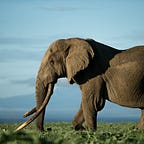Wild pigs “carbon hoofprint” causes climate change? You must be kidding.
New research shows invasive pigs emit nearly 5 million tons of carbon dioxide a year — the equivalent of about 1.1 million cars — by uprooting carbon stored in soils. Koobi spoke with the author of the groundbreaking study to learn more.
Whatever you call them; hogs, swine, or boar, wild pigs are one of the most damaging invasive species on Earth. They destroy agriculture and kill native wildlife in areas where they are invading, including the Americas, Oceania, and parts of Southern Africa and Southeast Asia. But what do they have to do with climate change?
Well, by uprooting carbon trapped in soil, wild pigs may be releasing around 5 million tonnes of carbon dioxide annually across the globe. The equivalent of 1.1 million cars!
Koobi was lucky enough to speak with the author of the groundbreaking piece of research; Dr Christopher J. O’Bryan.
Chris hails from the backwoods of Tennessee and has an accent to match. He did his PhD at the University of Queensland in Australia and has become one of the world’s leading conservation biologists publishing regularly in top journals. The best way to describe Chris is he’s half Davy Crocket and half Charles Darwin.
The problem with pigs
“Wild pigs are just like tractors ploughing through fields, turning over soil to find food,” Chris said.
“When soils are disturbed carbon dioxide can be released into the atmosphere.”
“Since soil contains nearly three times as much carbon than air, even a small fraction of carbon emitted from soil has the potential to accelerate climate change.”
Chris used models on wild pig numbers and their locations. He then simulated 10,000 maps of potential global wild pig density. Before modeling the amount of soil area disturbed across a range of climatic conditions, vegetation types and elevations spanning lowland grasslands to sub-alpine woodlands. From this, he estimated carbon emissions.
“Our models show a wide range of outcomes, but they indicate that invasive wild pigs are likely currently uprooting an area of around 36,000 to 124,000 square kilometres, in environments where they’re not native.” Chris said. “To add perspective, this is an area between the sizes of Taiwan and England.”
“This is an enormous amount of land, and this not only affects soil health and carbon emissions, but it also threatens biodiversity and food security that are crucial for sustainable development.”
Their carbon hoofprint
Previous research has highlighted the potential contribution of wild pigs to greenhouse gas emissions, but only at local scales.
For example, in Swiss hardwood forests wild pigs caused soil carbon emissions to increase by around 23% per year. Similarly, in the Jigong Mountains National Nature Reserve in China soil emissions increased by over 70% per year in places disturbed by wild pigs.
Chris’s study is the first effort to calculate their carbon hoofprint globally.
He found wild pigs release about 5 million tonnes of carbon dioxide each year — the same as one million cars. The majority of these emissions occur in Oceania.
What can be done?
“Wild pig control is difficult and costly due to their cunning behaviour, rapid breeding rate, and tough nature.”
“Pigs have even been known to avoid traps if they had been previously caught, and they are skilled at changing their behaviour to avoid hunters.”
In Australia, management efforts include coordinated hunting events to slow the spread of wild pig populations. Other techniques include setting traps and installing fences to prevent wild pig expansion, or aerial control programs.
Some of these control methods can also cause substantial carbon emissions, such as using helicopters for aerial control and other vehicles for hunting. Still, the long-term benefits of wild pig reduction may far outweigh these costs.
“Working towards reduced global emissions is no simple feat, and our study is another tool in the toolbox for assessing the threats of this widespread invasive species.” Chris said.
“It’s clear that more work still needs to be done, but in the interim, we should continue to protect and monitor ecosystems and their soil which are susceptible to invasive species via loss of carbon.”
The original scientific research article can be found here if you would like more detail.
This piece is part of Koobi’s commitment to its customers to keep them up to date with everything important in the carbon world including the latest science. To offset your carbon footprint while conserving wildlife visit our website.
